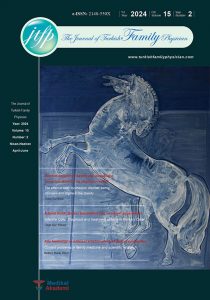Clinical education and the Field in Family Medicine Specialty Training
Health care both for acute and chronic diseases is mainly delivered in ambulatory clinics in the community. However the residency programme of the family physicians in Turkey who are trained for the delivery of primary health care services is maintained almost totaly in hospital rotations. So to deal with the suitable cases and to reach the learning objectives of the ambulatory care focused family medicine residency training is limited. Clinical teaching is the training in the health service. Clinical teaching was valid in medicine though it was understructured in the previous years when there was no standards for education and the apprentice was the only model that provides professional education. Also today it is advised to offer the same opportunity to the residents in all disciplines but to structure it. Practice based and community based learning is indispensable for the disciplines which are practice based like family medicine. Training in practice in the community other than the health care delivery in inpatient clinics offers the chance of observing, discussing, demonstrating the real family medicine care, improving the skills by taking feedback and a real competency assessment for residents. In a phrase, a family medicine resident must have teaching in the ambulatory practice that is the real environment to work, to be aware of the differences and to learn. “Training in practice” will provide learning in the real context. The educators of this practice based training will be the family physicians who also deliver health care in the community based offices. The personal effort of this physician will not be enough to give either clinical teaching or health care in high quality. The clinical trainer must be prepared with necessary teaching skills besides the defined curriculum content and assessment methods. In our country “training in practice” must become legal primarily then take place in the curriculum and providing field trainers and training units in the field, establishing a community based education and practice center in the University departments which are ready about the education concept and to set collaboration with the all units.
References
- Bowen JL, Salerno SM, Chamberlain JK, Eckstrom E, Chen HL, Brandenburg S. Changing habits of practice. Transforming internal medicine residency education in ambulatory settings. J Gen Int Med 2005:20;1181-1187.
- Sprake C, Cantillon P, Metcalf J, Spencer J. Teaching in an ambulatory care setting. BMJ 2008; 337:a1156 doi: 10.1136/bmj.a1156.
- Steineert Y. Staff development for clinical teachers. Clin Teach 2005; 2:104-110.
- Spencer J. ABC of learning and teaching in medicine: Learning and teaching in the clinical environment. BMJ 2003;326;591-594.
- Bordagae G, Borack JH, Irby DM, Stritter FT. Education in ambulatory settings: developing valid measures of educational outcomes and other research priorities. Acad Med 1998;73:743-750.
- Irby DM.Teaching and learning in ambulatory care settings: a thematic review of the liteature. Acad Med 1995;70:898-931.
- Heidenreich C, Lye P, Simpson D, Lourich M. Educating child health professionals. The search for effective and efficient ambulatory teaching through the literature. Paediatrics 2000;105:231-237.
- Williams GC, Saizow RB, Ryan RM. The importance of self determination theory for medical education. Acad Med 1999;74:992-995.
- Ramani S, Leinster S. AMEE Guide no. 34: Teaching in the clinical environment. Med Teach 2008; 30: 347-364.
- Skeff KM. Enhancing teaching effectiveness and vitality in the ambulatory setting. J Gen Intern Med 1988; 3:S26-S33.
- Ringsted C, Henriksen AH, Skaarup AM, Van der Vleuten CP. Educational impact of in-training assessment (ITA) in postgraduate medical education: a qualitative study of an ITA programme in actual practice. Med Edu 2004; 38 (7):767-777.
- Velmahos GC, Toutouzas KG, Sillin LF ve ark. Cognitive task analysis for teaching technical skills in an inanimate surgical skills laboratory. Am J Surg 2004; 187(1):114-119.
- Issenberg SB, McGaghie WC, Petrusa ER, Lee Gordon D, Scalese RJ. Features and uses of high-fidelity medical simulations that lead to effective learning: a BEME systematic review. Med Teach 2005; 27(1):10-28.
- Nair BR, Alexander HG, McGrath BP, Parvathy MS, Kilsby EC, Wenzel J ve ark. The mini clinical evaluation exercise (mini-CEX) for assessing clinical performance of international medical graduates. Medical Journal of Australia 2008; 189: 159
- http://www.saglik.gov.tr/TR/belge/1-10376/aile-hekimligi-uygulama-yonetmeligi.html, Adresinden 28/12/2010 tarihinde eriþilmiþtir.
- http://www.ailehekimligi.gov.tr/index.php?option=com_content&view=article&id=760:aile-hekimlii-bilgi-sistemi-ahbs adresinden 28.12.2010 tarihinde eriþilmiþtir.
- Papanikolaou PN, Christidi GD, Ioannidis JPA. Patient outcomes with teaching versus nonteaching healthcare: A systematic review. PLoS Medicine 2006;3(9):341
- Roth LM, Severson RK, Probst JC, Monsur JC, Markova T, Kushner SA, Schenk M. Exploring physician and staff perceptions of the learning environment in ambulatory residency clinics. Family Medicine 2006;38(3):177-184.
- Kulaga ME, Charney P, O’Mahony SP, Cleary JP, McClung TM, Schildkam DE. The positive impact of initiation of hospitalist clinician educators resource utilization and medical resident education. J Gen Intern Med 2004;19:293-301.
- Scott I, Sazegar P. Why community physicians teach students (or not): barriers and opportunities for preceptor recruitment. Med Teach 2006;28(6):563-565.



